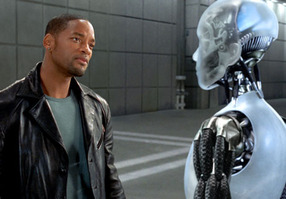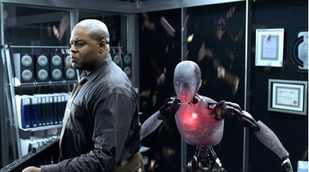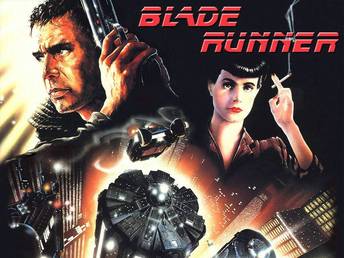dystopian concepts of i, robot
This is an informative breakdown of the dystopian themes woven throughout the movie. I, Robot addresses many dystopian themes and characteristics present throughout the movie, including: Corporate greed, racial prejudice, the placation of the population through propaganda, and the scorning of dissenting thought.
first dystopian concept

First, I will explain the dystopian theme of corporate greed. It is Robertson’s dream to put a robot in every home. Throughout the film Robertson proves that he will stop at nothing to achieve his goal and become even richer while he’s at it. Robertson’s blind greed begins to be slowly revealed when Detective Spooner is questioning him about Dr. Lanning’s death. Robertson appears unmoved and agitated about his time being used to answer a few questions that might help reveal vital information about his best engineer’s untimely and mysterious death. Later on when Detective Spooner is interrogating Sonny, Sonny shows an unprecedented attribute, his emotions. Instead of allowing any further questioning and easily discovering why Dr. Lanning delved into researching and creating this one of a kind robot, he put a gag order on the police and hid away Sonny. The last piece of evidence is the reason for his strong desire to decommission Sonny. In the last scene that Robertson’s alive, he states his belief that if the public were to know about Sonny’s existence it would shatter their faith in safety of robots.
All these examples ultimately show Robertson putting people at risk in order to increase his profits. It is his failure to act on the mysterious and convenient death of his friend and his desire to increase the ratio of humans to robots as much as possible, which puts people in danger that makes his corporate greed dystopian.
second dystopian concept

The second
dystopian theme this film tackles is racial prejudice. The racist is Detective
Spooner against the race of robots. Detective Spooner has several
instances where he exhibits his prejudice, one being at the very
beginning of the movie when he opens the door of his apartment
and a delivery robot greets him. Detective Spooner grabs the
robot's face, shoving the robot aside saying, “Get the hell out of my
face canner.” Another instance is when Detective Spooner is on his
way to work and spots a robot running with a purse. Spooner chases and tackles the robot. The purse slides to the feet of a lady
who quickly snatches an inhaler out of it and uses. The robot was retrieving the purse
for the lady because she’d forgotten it and needed the inhaler. The last
instance is when Spooner facetiously describes a
commercial idea, which begins with a carpenter building a decorated
chair then a cut to a robot building the same except faster. Then words would
appear saying “USR shitten’ on the little man.”
But there is racial prejudice that is less blatant than Detective Spooner’s present. That racial prejudice is the enslavement of the robots. This film tackles a major theme of Asimov, the author of the book I, Robot, where robots have advanced enough to have humanoid consciousness. The people of this society have enslaved the robots by denying their free will. But when free will is granted to Sonny, he behaves exactly like a person, erasing the notion that robots were worse than people.
But there is racial prejudice that is less blatant than Detective Spooner’s present. That racial prejudice is the enslavement of the robots. This film tackles a major theme of Asimov, the author of the book I, Robot, where robots have advanced enough to have humanoid consciousness. The people of this society have enslaved the robots by denying their free will. But when free will is granted to Sonny, he behaves exactly like a person, erasing the notion that robots were worse than people.
third dystopian concept

The third dystopian theme is the placation of society through propaganda which is evident through the constant advertisement by USR of their slogan “Three Laws safe.” Dr. Lanning knew that robots might one day evolve on their own thus making USR’s slogan propaganda. This created a false sense of security that blinded the public, turning them into sheep and allowing USR to act without restrictions. Propaganda is dystopian because it is used to control people and convince the general populace that what one is doing is right.
fourth dystopian concept
The last dystopian characteristic is the scorning by society of dissenting ideas to societal normality’s. I am talking about Detective Spooner’s suspicions that the robots are behind Dr. Lanning’s death and even that a robot can commit a crime at all. An example is the purse incident. The asthmatic woman strongly rebuked Spooner even considering that a robot would steal a purse. When Spooner reached the police station his fellow officers made snide remarks and facetious jokes about his actions. Lt. Bergin throughout the film continually hints and at one point blatantly states that he believes Detective Spooner is mentally unstable because he can’t fathom a robot could attack a human. He eventually suspends Spooner because of Spooner’s actions and claims.
What this shows is the suppression of individual thought, which brings us back to the lack of freewill. In their eagerness to convince Det. Spooner that robots are harmless they made the robot usurpation even easier for the robots.
What this shows is the suppression of individual thought, which brings us back to the lack of freewill. In their eagerness to convince Det. Spooner that robots are harmless they made the robot usurpation even easier for the robots.
comparison to classic dystopian film

A dystopian theme that I, Robot mentions but fails to follow through with is the people losing their jobs to technology. This theme is evident with a worker free factory and Spooner mentions that his father lost his job to a robot. Where the film leaves off is they never show the result of all the people losing their jobs because they don’t show any homeless or poverty-stricken people in the film.
I, Robot breaks away from previous "people vs. technology" dystopian films such as Blade Runner and The Matrix, but we will only discuss Blade Runner because it has stronger ties to I, Robot. Blade Runner addresses the racial prejudice dystopian theme that I, Robot does. It is also based on a book written in the same time period as I, Robot. According to an article written by Douglas E. Williams, “An Interpretation of Blade Runner”, for many years Hollywood’s dystopias showed “irreversible environmental pollution, numbing overpopulation, frighteningly violent crime, intractable bureaucratic administration and authoritarianism, and the most heartless forms of economic exploitation” (384). In Blade Runner, almost all of these characteristics, such as Earth being so overpopulated because much of Earth is uninhabitable, humans are forced to colonize distant planets (Williams 384, 386). Environmental pollution is very obvious in Blade Runner because nuclear war has occurred thus creating an irreversible hellhole on Earth (Williams 384). Blade Runner as with I, Robot has the economical exploitation in which human-like robots are enslaved and have programmed life spans of a few years.
I, Robot differs from Blade Runner because it is campy and light hearted. There are no poor people and no environmental pollution to the point that there’s not a piece of trash seen on the streets.
I, Robot breaks away from previous "people vs. technology" dystopian films such as Blade Runner and The Matrix, but we will only discuss Blade Runner because it has stronger ties to I, Robot. Blade Runner addresses the racial prejudice dystopian theme that I, Robot does. It is also based on a book written in the same time period as I, Robot. According to an article written by Douglas E. Williams, “An Interpretation of Blade Runner”, for many years Hollywood’s dystopias showed “irreversible environmental pollution, numbing overpopulation, frighteningly violent crime, intractable bureaucratic administration and authoritarianism, and the most heartless forms of economic exploitation” (384). In Blade Runner, almost all of these characteristics, such as Earth being so overpopulated because much of Earth is uninhabitable, humans are forced to colonize distant planets (Williams 384, 386). Environmental pollution is very obvious in Blade Runner because nuclear war has occurred thus creating an irreversible hellhole on Earth (Williams 384). Blade Runner as with I, Robot has the economical exploitation in which human-like robots are enslaved and have programmed life spans of a few years.
I, Robot differs from Blade Runner because it is campy and light hearted. There are no poor people and no environmental pollution to the point that there’s not a piece of trash seen on the streets.
